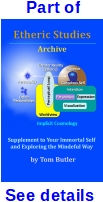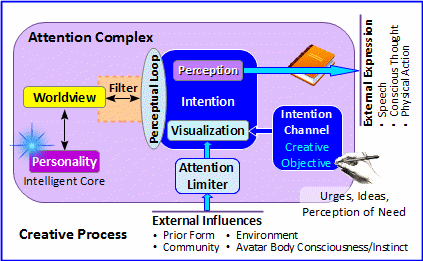Abstract
 From the perspective of the Implicit Cosmology, traditional body-mind-spirit can be seen as three life fields: The life field associated with the human body is more better seen as a morphic field; the life field associated with mind is your etheric personality as your intelligent core for which your conscious self is just an outward expression; and, the life field associated with Source as the “reality field,” of which all other life fields are aspects. This essay explores the relationship amongst these fields
From the perspective of the Implicit Cosmology, traditional body-mind-spirit can be seen as three life fields: The life field associated with the human body is more better seen as a morphic field; the life field associated with mind is your etheric personality as your intelligent core for which your conscious self is just an outward expression; and, the life field associated with Source as the “reality field,” of which all other life fields are aspects. This essay explores the relationship amongst these fields
Introduction
The traditional view of awareness is to say that people have conscious and unconscious awareness (mind). The usual definition for consciousness is the awareness of existence due to sensation from the surroundings. The unconscious would be an unaware acknowledgment of external stimuli. Consciousness is the awake state of a person while unconscious is usually expressed as unintended reactions and the source of temperament.
The unconscious mind is often described as the subconscious. Some dreams can be thought of as a window on the subconscious. Personality quirks are often attributed to some event of the person’s past which remains in the unconscious to influence behavior as the person’s temperament.
There are a number of influences which combine to characterize consciousness and unconsciousness:
Body Consciousness: A degree of awareness by the body mind is seen as influencing unconscious behavior. In this, the hindbrain which is thought to have evolved with the body, is responsible for the functioning of the body and the seat of such instincts as survival, feeding, reproduction, family and territory.
These instincts clearly have a direct influence on the unconscious and are often experienced as “natural behavior” as they influence conscious behavior. There is a complex of behaviors which seem to be without obvious reason and which are often given vague explanations such as “hormones” or “middle-age crises.” These are thought to be the influence of the body mind which can override the ability of the conscious mind to reason, sometimes resulting in irrational fearful, exaggerated sexual urges and unwarranted anger.
Innate comprehension: (This is a corollary of the concept of progression described below.) There are considerable differences in comprehension amongst people, even amongst the very young. Mainstream science does not have a definitive explanation for the deviation, but inheritance from parents is probably the most popular. However, there has been no definitive explanation explaining a mechanism for this inheritance.
Based on the Trans-survival Hypothesis, comprehension is native to the etheric personality which becomes associated with the body at its birth. In this view, personality is thought to have existed before this lifetime and to have experienced something equivalent to other lifetimes, probably in other venues of learning. In principle, personality will take from this lifetime only a conceptual understanding of experiences as they are filtered by worldview. This is discussed in The Creative Process.
Also in principle, the only influence personality is able to bring to this lifetime is that which is able to pass through the filter of worldview, which in turn, is progressively constricted as the child is “educated” by society. In this view, the primary influence personality is able to bring is the governing influence of spiritual maturity it has acquired prior to this lifetime. This is thought to be expressed as comprehension and to have an influence on temperament.
A third view is that the morphic field associated with the child’s formation in the mother’s womb is influenced by the parent’s morphic fields. In light of other evidence supporting the Hypothesis of Formative Causation, this is a distinct possibility as a mechanism for inheritance.
Further speculation would be that the personality is energetically in agreement with the field which enables it to associate with the baby. This etheric-to-physical influence rather than a physically evolved influence, is a concept that can be expected to be further developed as the idea of morphic fields is further integrated into the survival hypothesis.
Progression: A fundamental assumption of this cosmology is that personalities produce aspects of themselves to gain understanding about their environment. A measure of understanding is progression from initial expression of curiosity to realization of understanding. From the perspective of Source, creation is with the intention to understand. Realization of understanding is hierarchical as the nested fields are collapsed with each advance in understanding.
Temperament: As described in the essay, Point of View, a person’s point of view is expressed as typical temperament or characteristic behavior. For instance, a person, even from birth, might have little tolerance for irritation or might be more prone to outbursts of emotion. It is clear that different people have different ways of learning, as some might prefer to watch others to learn while some might need to physically experience something to learn. Perhaps that is why some people still prefer to read about what they want to know on the Internet while others gravitate to video presentations.
Temperament is possibly an aspect of comprehension; however, an open question is whether or not a child’s temperament is inherited from a family member. The mainstream view is that either genes (nature) determine personality or environment (nurture) is the dominant determinant. In Sheldrake’s Hypothesis of Formative Causation, it would be nature’s habit established by preceding generations. From the perspective of the Trans-survival Hypothesis, a third possibility is that the personality entered into this lifetime with a temperament developed from prior experiences.
Point of View
The term, point of view, is used by ATransC in a specific way to indicate the perspective a person has when experiencing the world. As self-identity, it is the “I am this” of who we are. Terms like “viewpoint” and “perspective” are used in a more generic sense to represent attitude and place from which something is experienced.
Point of view is portable in that a person’s sense of “I am this” may shift from the waking state of the physical body, to the dream state, meditative states or the occasional lucid awareness perspective of the person’s etheric personality. Thus, when a person is conscious, the point of view is from the perspective of sensing the environment from the physical body’s perspective. That is, the person has the sense of being the body.
Having the sense of being the body is an important point. People generally do not experience themselves as some “little me” inside of the body, looking out at the world. When fully entangled with the body, a person senses the body as who they are and finds it virtually impossible to imagine otherwise. One of the objectives of this cosmology is to show that people are more than their physical body.
Point of view is informed by worldview, which in turn is informed by personality, body mind and the environment. As is shown in The Creative Process, it is thought that personality is unable to directly influence perception which is point of view for that model. While the creative process model is functionally correct, think of the relationship between point of view and personality as a “dotted line” of direct influence. The objective of personal progression is to make that dotted line connection as lucid as possible by working to make worldview agree with nature and not be based on popular wisdom.
Etheric Personality
![]() If the physical body is a person’s avatar, then the person’s personality is native to some aspect of etheric space. The path through which the person influences the avatar and experiences the results is by way of Personality as shown in the creative process diagram below. Worldview acts as a filter through which the influence and perception must pass.
If the physical body is a person’s avatar, then the person’s personality is native to some aspect of etheric space. The path through which the person influences the avatar and experiences the results is by way of Personality as shown in the creative process diagram below. Worldview acts as a filter through which the influence and perception must pass.
The part marked “Experience” in the drawing represents physical awareness or point of view which is who the person identifies with when immersed in the avatar’s world. With this in mind, it is useful to note that, in transcommunication such as mediumship and Instrumental TransCommunication, the communication also “enters” into the physical awareness by way of the worldview.
The diagram here is intended to represent the relationship between the etheric personality (the large star) and the human avatar. The bright spot in the avatar’s forehead represents that part of personality that is able to be expressed into the physical as moderated by worldview. The clarity of this channel is referred to as lucidity.

Etheric Fields
As discussed in Etheric Fields, it is useful to think of everything having an associated field of subtle, not energy but potential, which represents its intended form and directs its formation. This organizing influence is especially evident as the governing principle in morphogenesis which is the process determining how the first cells differentiate to produce different parts of an organism.
The work of Rupert Sheldrake has been very helpful in making sense of this concept. The morphic fields he describes in the Hypothesis of Formative Causation are described here as etheric fields. While Sheldrake leaves open the possibility that the influence for the first occurrence of a form and its subsequent evolution is intention, the Trans-survival Hypothesis is very specific that it is the effect of intended order.
Point of View as an Etheric Field
It is here that the cosmology becomes less well defined. Consciousness is complex and does not lend itself well to generalizations. The intention here is to describe mind as a many-faceted complex of etheric fields. With the exception of personality, all are products of the physical body’s evolution and inherit physical-world habits via morphic resonance. Personality is a product of a very different line of evolution, conceptualized here as evolving from other etheric personalities.
The organizing morphic field is associated with point of view, but it is not clear if point of view is the dominant organizer or if whatever aspect of mind point of view is associated with at any one moment in time is the organizing field. In a practical sense, point of view is the organizing field, making it the top field of mind. That little detail will require much more consideration. These essays will be evolved as more is understood.
The levels of consciousness are seen here as morphic fields:
Body Mind: The avatar (physical body) is managed by its body consciousness which also drives its behavior when not overridden by the conscious mind.
Unconscious Mind: The unconscious mind governs a host of behaviors associated with maintenance of the body and is greatly influenced by body consciousness.
Conscious Mind: The conscious mind is probably best described as the outward expression of the body and unconscious minds. This is what manages the physical senses and the mobility of the body.
Personality: The personality can be considered the root field since the avatar inherits purpose from personality. The body would function just fine without personality, albeit dominated by more primitive behavior. Personality can be seen as the source of purpose beyond evolved instincts. Understanding gleaned from experience can be attributed to the personality’s increasing maturity.
![]()
